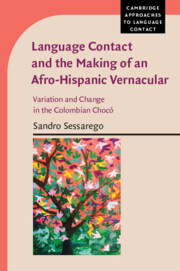 Language Contact and the Making of an Afro-Hispanic Vernacular
Language Contact and the Making of an Afro-Hispanic Vernacular Book contents
- Language Contact and the Making of an Afro-Hispanic Vernacular
- Cambridge Approaches to Language Contact
- Language Contact and the Making of an Afro-Hispanic Vernacular
- Copyright page
- Dedication
- Contents
- Figures
- Tables
- Maps
- Series Editor’s Foreword
- Acknowledgments
- 1 Introduction
- 2 The Place of Chocó Spanish in the Spanish Creole Debate
- 3 A Sketch of Chocó Spanish
- 4 Roots of Some Languages
- 5 Black Slavery in the Pacific Lowlands of Colombia
- 6 Testing the Legal Hypothesis of Creole Genesis on Colonial Chocó
- 7 Final Considerations
- Appendix
- References
- Index
5 - Black Slavery in the Pacific Lowlands of Colombia
Published online by Cambridge University Press: 23 August 2019
- Language Contact and the Making of an Afro-Hispanic Vernacular
- Cambridge Approaches to Language Contact
- Language Contact and the Making of an Afro-Hispanic Vernacular
- Copyright page
- Dedication
- Contents
- Figures
- Tables
- Maps
- Series Editor’s Foreword
- Acknowledgments
- 1 Introduction
- 2 The Place of Chocó Spanish in the Spanish Creole Debate
- 3 A Sketch of Chocó Spanish
- 4 Roots of Some Languages
- 5 Black Slavery in the Pacific Lowlands of Colombia
- 6 Testing the Legal Hypothesis of Creole Genesis on Colonial Chocó
- 7 Final Considerations
- Appendix
- References
- Index
Summary
The colonial and postcolonial history of Chocó is strongly connected to the sociopolitical development of its surrounding regions. In fact, the powerful miners residing in Antioquia, Cali, and Popayán were those who originally pushed the Spanish colonial enterprise toward this remote frontier until conquering the region, one of the richest mineral areas of the Americas (Colmenares 1979). In particular, the principal actors in this colonial mission were the mining families from Popayán, who, after several attempts to penetrate the region, finally managed to defeat the native populations by the end of the seventeenth century (Hansen 1991). From that point until the abolition of slavery in 1851, several white entrepreneurs entered the region with their gangs of black slaves (cuadrillas) to exploit the rich gold mines of the province. In 1851, slavery was formally abolished in Colombia. This resulted in a shortage of labor force in the Chocó mines. Consequently, the majority of the white people residing in the region abandoned the area, leaving behind their former slaves, whose descendants form today more than 90 percent of the local population (Sharp 1976).
- Type
- Chapter
- Information
- Language Contact and the Making of an Afro-Hispanic VernacularVariation and Change in the Colombian Chocó, pp. 127 - 148Publisher: Cambridge University PressPrint publication year: 2019


